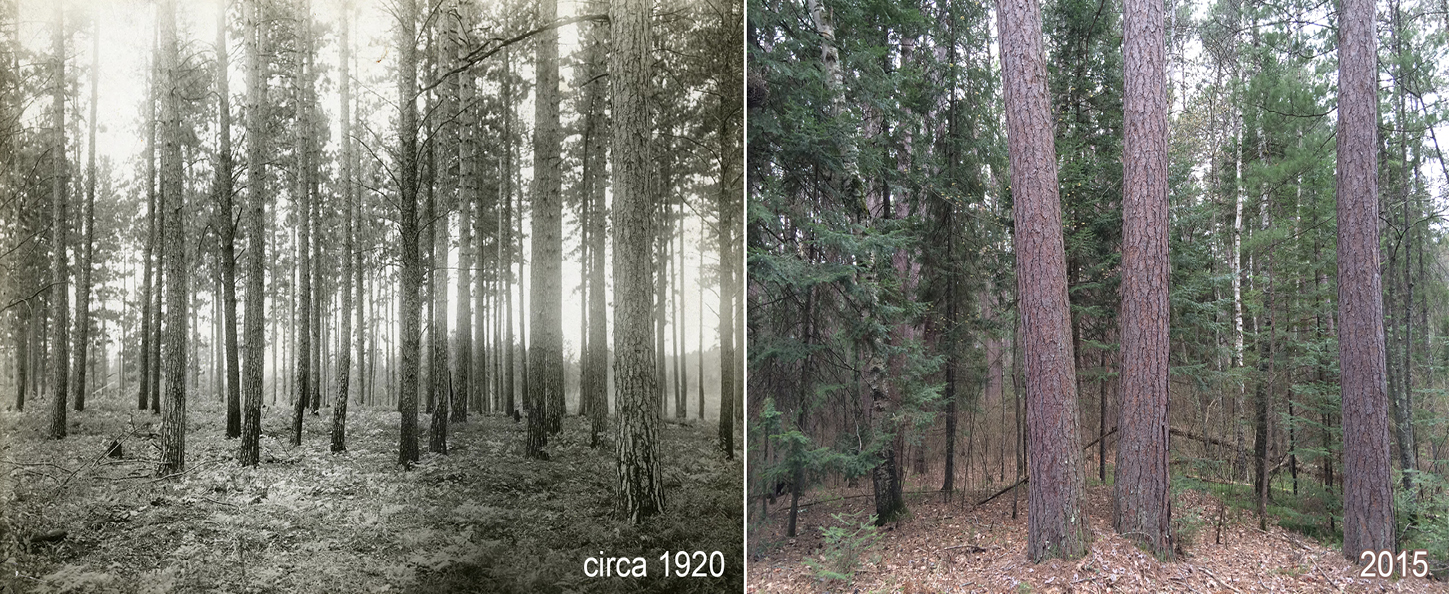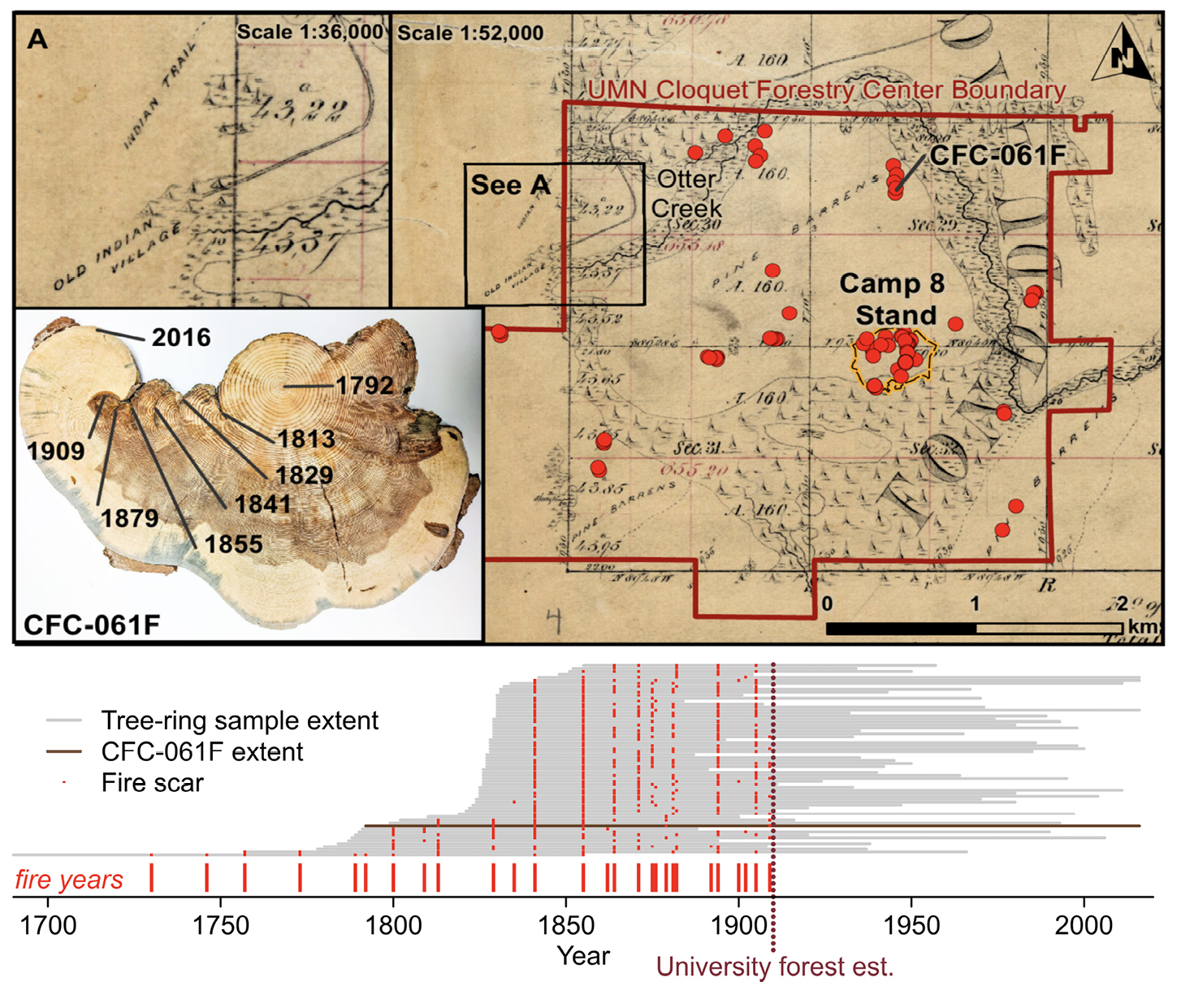- Home
- Publications
- PAGES Magazine
- Blending Tree-ring Fire-scar Records and Indigenous Memory In Northern Minnesota, USA
Blending tree-ring fire-scar records and Indigenous memory in northern Minnesota, USA
Johnson LB, Larson ER, Gill KG and Savage J
Past Global Changes Magazine
30(1)
36-37
2022
Lane B. Johnson1, E.R. Larson2, K.G. Gill1 and J. Savage3
Tree-ring records of frequent fire in northern Minnesota are increasingly recognized as eco-cultural phenomena. Indigenous perspectives provide the cultural context to reinterpret tree-ring fire-scar records in ignition-limited systems like the Upper Great Lakes Region.
People in the fire environment of the Upper Great Lakes Region
Ideal environmental policy represents a synthesis of ecological knowledge, diverse values, and cultures that guides collective action toward balanced outcomes. Achieving this ideal may seem daunting, but lessons for Western scientists provided by paleoecological records are increasingly clear in how best to pursue it: listen. Quantitative environmental history derived from proxies like charcoal, pollen, and tree rings illustrate the what of history; engaging with Indigenous knowledge systems is how researchers might better understand the why of history. Such is the emerging case of fire history research at the University of Minnesota Cloquet Forestry Center, USA, where the tree-ring record of frequent fire (what) is being re-examined as an eco-cultural phenomenon (why).
The vegetation communities of the Upper Great Lakes Region of North America assembled over millennia following the recession of continental ice sheets. Two factors were part of this process since time immemorial: fire and people. For the last 12,000 years people have been an integral component of fire-shaped landscapes, influencing when and where fires burned. Indigenous people modified vegetation conditions over generations, reinforcing and accentuating landscape patterns through the intentional application of fire long before Euro-American colonization reshaped fire dynamics to a largely fire-excluded state. Here, we report on part of a growing network of tree-ring-based fire-history sites in the Upper Great Lakes Region to convey how a cross-cultural perspective better explains the causes of frequent fire in forest ecosystems widely considered to be ignition-limited (Balch et al. 2017).
Indigenous land with University of Minnesota presence since 1909
Nagaajiwanaang, the Reservation of the Fond du Lac (FDL) Band of Lake Superior Chippewa – known as Anishinaabe/g [sing./plural], meaning the "original people", and part of a group of culturally affiliated tribal communities in the Great Lakes region of North America – was established through the 1854 Treaty of La Pointe and opened to Euro-American colonization by the United States government in 1905. Through the contentious process of allotment, "excess" Anishinaabe land was sold to Euro-Americans, advancing the encroachment of white colonizers on lands once held collectively by the FDL Anishinaabe (Akee 2020). The University of Minnesota Cloquet Forestry Center (University forest) is one example of the 86 million acres of Indigenous lands removed from collective ownership between 1905 and 1909 in the United States (Catton 2016). This dramatic shift in land ownership coincided with concerted state and national efforts to suppress wildland fires and terminate Indigenous cultures.
The University forest is a 1375-hectare research forest established within the FDL Reservation in 1909 near the lumber mill city of Cloquet. The University forest is 50 km southwest of Lake Superior (Gichi-Ojibwe-gamiing) and lies on a rolling sand plain that spans a subtle height of land between the Lake Superior and Mississippi River (Mishi-ziibi) watersheds. Fire-shaped pine barrens functioned as an overland travel corridor that connected the historical and contemporary FDL communities of Cloquet (Mookomaani-onigaming) and Sawyer (Gwaaba-iganing). A narrow stream called Otter Creek (Nigigo-ziibiwishe) is the most distinctive perennial water feature in the University forest.
Establishment of the University forest coincided with a campaign to entirely exclude fire from the property following widespread logging. The primary goal of the first forester-in-charge was to create a network of roads and fire breaks to prevent the loss of timber resources to fire. The work was effective. Interestingly, university records indicate no lightning-caused fires on the forest since 1910. Human-caused fires, however, were common, with "blueberry pickers" linked to several ignitions in the early 1900s (Schantz-Hansen 1960). By 1933, additional resources and workforce brought an end to reoccurring human-caused wildfires. Over the same period, university researchers documented the fire-influenced character of the forest that was typical of many pine forests in the region, with a ground cover of abundant wild blueberry plants (miinagaawanzh; Vaccinium angustifolium, V. myrtilloides) and other species typical of fire-maintained sites (Fig. 1; Schantz-Hansen 1923). Wood sections from fire-scarred red pine identified at least five fire years between 1820 and 1894 (Schantz-Hansen 1931).
An expanded tree-ring fire-scar record
Dendrochronological research in 2016–17 updated and expanded fire history for the University forest based on fire scars recorded by 64 red pine (bapakwanagemag; Pinus resinosa) stumps and snags. Twenty-seven fires were documented between 1730 and 1909, after which fires abruptly stopped (Fig. 2). The open forest conditions of the early 1900s had developed amidst frequent, low-severity fires, yet the current fire-free interval for much of the forest is over 115 years. Information shared by FDL community members since 2017 reinforced the likelihood that fire absence over the last century is better explained by the decline of intentional ignitions than fire suppression alone.
Cultural context from Indigenous oral history
Diverse sources document Great Lakes Anishinaabe relationships with many plants associated with fire-influenced sites. Wild blueberry (miinan) was a particularly important food and medicine in Anishinaabeg economies (Norrgard 2014), and "blueberry pickers" knew that the abundance of heavily-fruiting blueberry plants was most predictable in recently burned areas. Anishinaabe memories of berrying traditions are widely held (Peacock 1998), and fire-maintained berrying sites were visited each summer for a harvest that lasted up to six weeks. Anishinaabe knowledge-keepers often share that their ancestors tended blueberry sites with the regular application of fire to rejuvenate blueberry plants (Berkes and Davidson-Hunt 2006). With the great disruption of traditional land-use practices since colonization, there is fading knowledge of specific berrying sites where fire was regularly used. In cases where place-based information has been lost, recorded Indigenous oral history can supplement community memory.
In the case of the University forest, a group of Fond du Lac tribal elders interviewed in the late 1970s (Boundary Changes 1978–1979) recalled a thriving berry economy circa 1900 centered on what is now the University forest. One of the knowledge-keepers, Elizabeth Danielson, was born in 1888 and referred to vegetation conditions in her mother's time. The land around Otter Creek was "not heavily timbered then" but "brush like, regular blueberry country" (Danielson 1978). Prior to University acquisition, the Otter Creek headwaters was a destination for Anishinaabe families during the blueberry season, one of only two times each year when families from across the reservation would gather in one place (Danielson 1978). The abundance of berries was such that buyers would travel from Cloquet to Otter Creek daily to purchase berries by the bushel, paying 10 cents a quart (Whitebird 1978). Evidence of this traditional community use was recorded in the 1868 General Land Office survey as an "Indian trail" and "old Indian camp" just north of Otter Creek, opposite swaths of pine barrens observed to the south and east (Fig. 2).
With the exclusion of Anishinaabe land-tending practices following establishment of the University forest, blueberry production declined, an unintended consequence of Euro-American fire exclusion practices. Frank Whitebird stated directly the effects of white settlement and changed land-use on the University forest and the broader FDL Reservation: Blueberries were "…like cranberries you know. After white man gets them. No more cranberries." (Shabaiash 1979).
Fire restoration with blended knowledge as guide
Blending tree-ring fire history with Indigenous memory enhances our ability to interpret the fire record and vegetation change in the Upper Great Lakes Region. Fire-scarred trees serve as tangible reminders of fire's importance in shaping landscape biodiversity and ecological integrity. When cultural context is provided, fire-scarred trees and remnants become biocultural artifacts and discrete components of Indigenous cultural landscapes. When the tree-ring fire-scar record is understood as an eco-cultural phenomenon, it undermines the terra nullius, or "the land of no one", narrative that has shaped public discourse on North American wildlands for over a century (Vinyeta 2021).
A convergence of tree-ring fire history, contemporary Indigenous knowledge, and documented oral history on the Fond du Lac Reservation explains the mechanisms behind the frequent fire record at the University forest and highlights fire restoration as the continuation of a long relationship between people and land. The tree-ring fire record at the University forest matches patterns of fire history across large portions of the Upper Great Lakes Region where frequent fire was shut off with the widespread colonization of Indigenous lands circa 1900. A blended knowledge approach to fire history creates the potential to transform how tree-ring fire records are applied to contemporary, cross-cultural forest stewardship with fire restoration as both an ecological process and traditional cultural practice. This blended knowledge approach is guiding collaborative fire restoration at the University forest.
Acknowledgements
Miigwech to Gwiiwizens aka Ricky DeFoe for sharing his knowledge of Anishinaabemowin language for this piece.
affiliations
1Cloquet Forestry Center, University of Minnesota, USA
2Department of Geography, University of Wisconsin-Platteville, USA
3Fond du Lac Cultural Center and Museum, Fond du Lac Band of Lake Superior Chippewa, Cloquet, MN, USA
contact
Lane B. Johnson: lbj umn.edu
umn.edu
references
Akee R (2020) J Econ Race Policy 3: 123-143
Balch JK et al. (2017) Proc Natl Acad Sci USA 114: 2946-2951
Berkes F, Davidson-Hunt IJ (2006) Int Soc Sci J 58: 35-47
Catton T (2016) American Indians and national forests. University of Arizona Press, 384 pp
Peacock T (1998) A forever story: The people and community of the Fond du Lac Reservation. Fond du Lac Band of Lake Superior Chippewa, 320 pp
Schantz-Hansen T (1923) J For 21: 802-806
Schantz-Hansen T (1931) J For 29: 48-53
Vinyeta K (2021) Environ Sociol, doi:10.1080/23251042.2021.1987608


